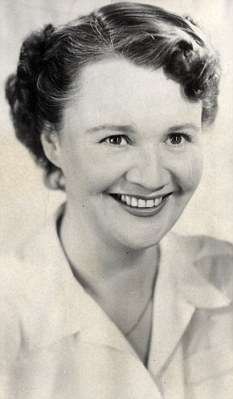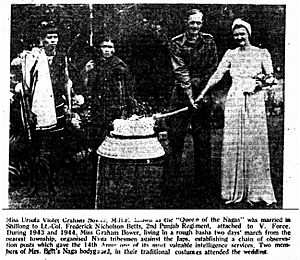Ursula Graham Bower facts for kids
Quick facts for kids
Ursula G. Bower
|
|
|---|---|
 |
|
| Born | 15 May 1914 England
|
| Died | 12 November 1988 (aged 74) |
| Education | Roedean School |
| Occupation | Anthropologist among the Nagas of the Naga Hills |
| Known for | Leader of "Bower Force", Naga guerillas fighting Japanese armies that invaded Burma |
|
Works
|
Monographs on the Nagas and the Apatani |
| Spouse(s) | Frederick Nicholson Betts |
| Parent(s) | John Graham Bower, stepmother Barbara Euphan Todd |
Ursula Violet Graham Bower MBE (later known as U. V. G. Betts) was an amazing British woman. She was born on May 15, 1914, and passed away on November 12, 1988. Ursula was one of the first people to study different cultures (an anthropologist) in the Naga Hills of India. She lived there from 1937 to 1946. During World War II, she also became a brave leader. She led a group of local fighters against the Japanese army in Burma between 1942 and 1945.
Contents
Early Life and Education
Ursula Bower was born in England in 1914. Her father was Commander John Graham Bower, a naval officer. Ursula went to Roedean School, a well-known school. She wanted to study archaeology at Oxford University. However, her family did not have enough money for her to finish school. In 1932, her father remarried. Ursula's stepmother became Barbara Euphan Todd. She was a children's writer who created the famous scarecrow character, Worzel Gummidge. That same year, Ursula traveled to Canada.
Adventures in India
Ursula first visited India in 1937. She went to the Naga Hills and Manipur. She was invited by a friend, Alexa Macdonald. Alexa's brother worked in the Indian Civil Service in Imphal. Ursula's mother hoped she would find a husband there. Instead, Ursula fell in love with the Naga Hills and its people.
She returned to India alone in 1939. She wanted to take photos and do some medical work. She also hoped to write a book. Ursula spent several years living among the Naga people. She took more than a thousand photos. These pictures showed the daily lives of the local tribes. Later, these photos were used in important studies.
Ursula's Role in World War II
When World War II began, Ursula was in London. But she planned to go back to the Naga Hills. She got permission from the British government. This allowed her to live in Laisong village. She became good friends with the local village leaders.
In 1942, the Japanese army invaded Burma. They threatened to move into India. The British government asked Ursula for help. They wanted her to organize the local Nagas. Her job was to form a group of scouts. These scouts would search the jungle for Japanese soldiers.
Ursula gathered the Nagas to fight the Japanese. She led about 150 Nagas. They only had old guns. They covered about 800 square kilometers (300 sq mi) of jungle. General Slim saw her amazing work. He sent her weapons and more fighters. Her group became known as "Bower Force." It was part of a larger unit called V Force.
Bower Force became very effective. The Japanese even offered a reward for her capture. An American comic book was made about her. It was called Jungle Queen. Ursula's favorite weapon was the Sten gun. She used two of them so much they wore out! Her father had taught her to shoot as a child. She was very good at using guns. She also trained her Naga scouts to use them.
Ursula set up guards on trails. She created a system to watch and warn. Thousands of people used these trails. They were escaping from Burma to India. These included refugees, soldiers, and airmen. Ursula also led the Nagas in ambushes. They would surprise Japanese search parties.
For her brave actions, Ursula received an award. On April 24, 1945, she became a Member of the Order of the British Empire. In 1944, she also received the Lawrence Memorial Medal. This award was for her work studying the Naga people.
After the War
Ursula never had formal training in anthropology. However, her photos, films, and books were very important. Her two books were about the Nagas and the Apatani. These works made her a leading anthropologist. In 1950, she earned a special diploma in anthropology. This was from the University of London.
Personal Life and Family
Ursula met Lieutenant Colonel Frederick Nicholson Betts during the war. He was also serving in V Force in Burma. They got married in July 1945. Frederick, known as Tim, became a political officer. He worked in the remote Subansiri region near Tibet. Ursula and Tim worked together. They helped create good relationships. They also calmed fighting between the Dafla and Apa Tani tribes.
After India became independent, they moved back to Britain in 1948. They then moved to British Kenya to grow coffee. But they left Kenya because of local unrest. They then moved to the Isle of Mull in Scotland. There, they raised their two daughters, Catriona and Alison Betts. Both daughters went to Roedean School, like their mother. They later went to university. After her marriage, Ursula was known as U. V. G. Betts. Her important papers are kept at the Centre of South Asian Studies. This is at the University of Cambridge.
Stories About Her Life
Ursula Betts' life has inspired many stories. Two radio shows on BBC Radio 4 were based on her life. They were called The Naga Queen and The Butterfly Hunt.
A documentary film was also made in 2011. It was called Captured by Women. This film showed some of Ursula Graham Bower's photos and film footage. It was about her time in Nagaland, India. The film was made by The Oxford Academy of Documentary Film. It also included work by Beatrice Blackwood. She was another important anthropologist.


